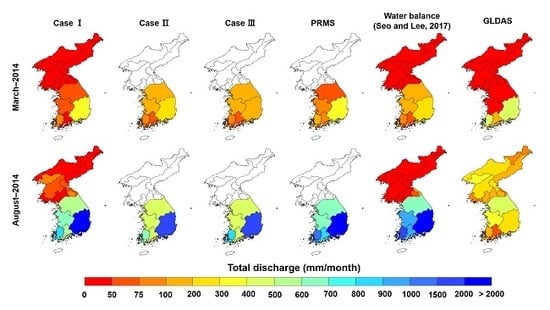Fusion of Multi-Satellite Data and Artificial Neural Network for Predicting Total Discharge
Abstract
1. Introduction
2. Study Area and Materials
2.1. Study Area
2.2. Independent Data
2.2.1. Terrestrial Water Storage Changes from the GRACE
2.2.2. Precipitation from TRMM
2.2.3. Soil Moisture Storage and Average Temperature from GLDAS
2.3. Dependent Data
2.4. Validation Data
3. Methodology
3.1. Water Balance-Based Total Discharge
3.2. Artificial Neural Network
3.2.1. Model Setup
3.2.2. Sensitivity Analysis
3.3. Conditional Merging
3.4. Metrics for Evaluation
4. Results
4.1. ANN-Predicted Total Discharge
4.2. Validation of ANN-Predicted Total Discharge
4.3. Spatial Distribution of Total Discharge
5. Conclusions
Author Contributions
Funding
Acknowledgments
Conflicts of Interest
References
- Wagner, T.; Sivapalan, M.; Troch, P.; Woods, R. Catchment classification and hydrologic similarity. Geogr. Compass. 2007, 1, 901–931. [Google Scholar] [CrossRef]
- Sayama, T.; Mcdonnell, J.J.; Dhakal, A.; Sullivan, K. How much water can a watershed store? Hydrol. Process. 2011, 25, 3899–3908. [Google Scholar] [CrossRef]
- Hannah, D.M.; Demuth, S.; van Lanen, H.A.J.; Looser, U.; Prudhomme, C.; Rees, G.; Stahl, K.; Taallaksen, L.M. Large-scale river flow archives: Important, current status and future needs. Hydrol. Process. 2011, 25, 1191–1200. [Google Scholar] [CrossRef]
- McCabe, M.F.; Rodell, M.; Alsdorf, D.E.; Miralles, D.G.; Uijlenhoet, R.; Wagner, W.; Lucieer, A.; Houborg, R.; Verhoest, N.E.C.; Franz, T.E.; et al. The future of earth observation in hydrology. Hydrol. Earth Syst. Sci. 2017, 21, 3879–3914. [Google Scholar] [CrossRef]
- Sheffield, J.; Wood, E.F.; Pan, M.; Beck, H.; Coccia, G.; Serrat-Capdevilla, A.; Verbist, K. Satellite remote sensing for water resources management: Potential for supporting sustainable development in data-poor regions. Water Resour. Res. 2018, 54, 9724–9758. [Google Scholar] [CrossRef]
- Rodell, M.; Velicogna, I.; Famiglietti, J.S. Satellite-based estimates of groundwater depletion in India. Nature 2009, 460, 999–1002. [Google Scholar] [CrossRef] [PubMed]
- Famiglietti, J.S.; Lo, M.; Ho, S.L.; Bethune, J.; Anderson, K.J.; Syed, T.H.; Swenson, S.C.; de Linage, C.R.; Rodell, M. Satellites measure recent rates of groundwater depletion in California’s Central Valley. Geophys. Res. Lett. 2011, 38, L03403. [Google Scholar] [CrossRef]
- Scanlon, B.R.; Faunt, C.C.; Longuevergne, L.; Reedy, R.C.; Alley, W.M.; McGuire, V.L.; McMahon, P.B. Groundwater depletion and sustainability of irrigation in the US High Plains and Central Valley. Proc. Natl. Acad. Sci. USA 2012, 109, 9320–9325. [Google Scholar] [CrossRef]
- Buma, W.G.; Lee, S.-I.; Seo, J.Y. Hydrological evaluation of Lake Chad Basin using space borne and hydrological model observations. Water 2016, 8, 205. [Google Scholar] [CrossRef]
- Seo, J.Y.; Lee, S.-I. Integration of GRACE, ground observation, and land-surface models for groundwater storage variations in South Korea. Int. J. Remote Sens. 2016, 37, 5786–5801. [Google Scholar] [CrossRef]
- Seo, J.Y.; Lee, S.-I. Total discharge estimation in the Korean Peninsula using multi-satellite products. Water 2017, 9, 532. [Google Scholar] [CrossRef]
- Houborg, R.; Rodell, M.; Li, B.; Reichle, R.; Zaitchik, B.F. Drought indicators based on model-assimilated Gravity Recovery and Climate Experiment (GRACE) terrestrial water storage observations. Water Resour. Res. 2012, 48, W07525. [Google Scholar] [CrossRef]
- Choi, C.; Kim, J.; Han, H.; Han, D.; Kim, H.S. Development of water level prediction models using machine learning in wetlands: A case study of Upo wetland in South Korea. Water 2019, 12, 93. [Google Scholar] [CrossRef]
- Sun, A. Predicting groundwater level changes using GRACE data. Water Resour. Res. 2013, 49, 1–13. [Google Scholar] [CrossRef]
- Young, C.-C.; Liu, W.-C. Prediction and modelling of rainfall-runoff during typhoon events using a physically-based and artificial neural network hybrid model. Hydrol. Sci. J. 2013, 60, 2102–2116. [Google Scholar] [CrossRef]
- Seo, J.Y.; Lee, S.-I. Spatio-temporal groundwater drought monitoring using multi-satellite data based on an artificial neural network. Water 2019, 11, 1953. [Google Scholar] [CrossRef]
- Vu, M.T.; Aribarg, T.; Supratid, S.; Raghavan, S.V.; Liong, S.-Y. Statistical downscaling rainfall using artificial neural network: Significantly wetter Bangkok? Theor. Appl. Climatol. 2016, 126, 453–467. [Google Scholar] [CrossRef]
- Tarpanelli, A.; Santi, E.; Tourian, M.J.; Filippucci, P.; Amarnath, G.; Brocca, L. Daily river discharge estimates by merging satellite optical sensors and radar altimetry through artificial neural network. IEEE Trans. Geosci. Remote Sens. 2019, 57, 329–341. [Google Scholar] [CrossRef]
- Ghafouri-Azar, M.; Bae, D.-H.; Kang, S.-U. Trend analysis of long-term reference evapotranspiration and its components over the Korean Peninsula. Water 2018, 10, 1373. [Google Scholar] [CrossRef]
- Landerer, F.W.; Swenson, S.C. Accuracy of scaled GRACE terrestrial water storage estimates. Water Resour. Res. 2012, 48, W04531. [Google Scholar] [CrossRef]
- Swenson, S.C. GRACE Monthly Land Water Mass Grids NETCDF RELEASE 5.0. Ver. 5.0; PO.DAAC: Santa Rosa, CA, USA, 2012. [Google Scholar]
- Koo, M.S.; Hong, S.Y.; Kim, J. An evaluation of the tropical rainfall measuring mission (TRMM) multi-satellite precipitation analysis (TMPA) data over South Korea. Asia-Pac. J. Atmos. Sci. 2009, 45, 265–282. [Google Scholar]
- Sohn, B.J.; Han, H.-J.; Seo, E.-K. Validation of satellite-based high-resolution rainfall products over the Korean Peninsula using data from a dense rain gauge network. J. Appl. Meteorol. Clim. 2010, 49, 701–714. [Google Scholar] [CrossRef]
- Kim, N.W.; Kim, H.J.; Park, S.H. Long-term runoff characteristics on HRU variations of PRMS. J. Korea Water Resour. Assoc. 2005, 38, 167–177. [Google Scholar] [CrossRef]
- Jung, I.W.; Bae, D.-H. A study on PRMS applicability for Korean River Basin. J. Korea Water Resour. Assoc. 2005, 38, 713–725. [Google Scholar] [CrossRef]
- Baek, K.; Lim, D. Study on Evaluating Low Flow in Ungauged Basin; Report on Gyeonggi Research Institute: Gyeonggi-do, Korea, 2010; pp. 1–178. [Google Scholar]
- Hao, Y.; Wilamowski, B.M. Levenberg-Marquardt Training, Industrial Electronics Handbook, Intelligent Systems, 2nd ed.; CRC Press: Boca Raton, FL, USA, 2011; pp. 12-1–12-15. [Google Scholar]
- Björck, A. Numerical Methods or Least Squares Problems; Society for Industrial and Applied Mathematics: Philadelphia, PA, USA, 1996. [Google Scholar]
- Olden, J.D.; Joy, M.K.; Death, R.G. An accurate comparison of methods for quantifying variable importance in artificial neural networks using simulated data. Ecol. Modell. 2004, 178, 389–397. [Google Scholar] [CrossRef]
- Garson, G.D. Interpreting neural network connection weights. AI Expert 1991, 6, 47–51. [Google Scholar]
- Beck, M.W. NeuralNetTools: Visualization and analysis tools for neural networks. J. Stat. Softw. 2018, 85. [Google Scholar] [CrossRef]
- Ehret, U. Rainfall and Flood Nowcasting in Small Catchments Using Weather Radar. Ph.D. Thesis, University of Stuttgart, Stuttgart, Germany, 2002. [Google Scholar]
- Sinclair, S.; Pegram, G. Combining radar and rain gauge rainfall estimates using conditional merging. Atmos. Sci. Lett. 2005, 6, 19–22. [Google Scholar] [CrossRef]
- Choi, J.G. Geostatistics; Sigma Press: Seoul, Korea, 2007. [Google Scholar]
- Lee, J.; Choi, M.; Kim, D. Spatial merging of satellite based soil moisture and in-situ soil moisture using conditional merging technique. J. Korea Water Resour. Assoc. 2016, 49, 263–273. [Google Scholar] [CrossRef]
- Jung, C.; Lee, Y.; Cho, Y.; Kim, S. A study of spatial soil moisture estimation using a multiple linear regression model and MODIS land surface temperature data corrected by conditional merging. Remote Sens. 2017, 9, 870. [Google Scholar] [CrossRef]
- Oyebode, O.; Stretch, D. Neural network modeling of hydrological systems: A review of implementation techniques. Nat. Resour. Model. 2019, 32, e12189. [Google Scholar] [CrossRef]
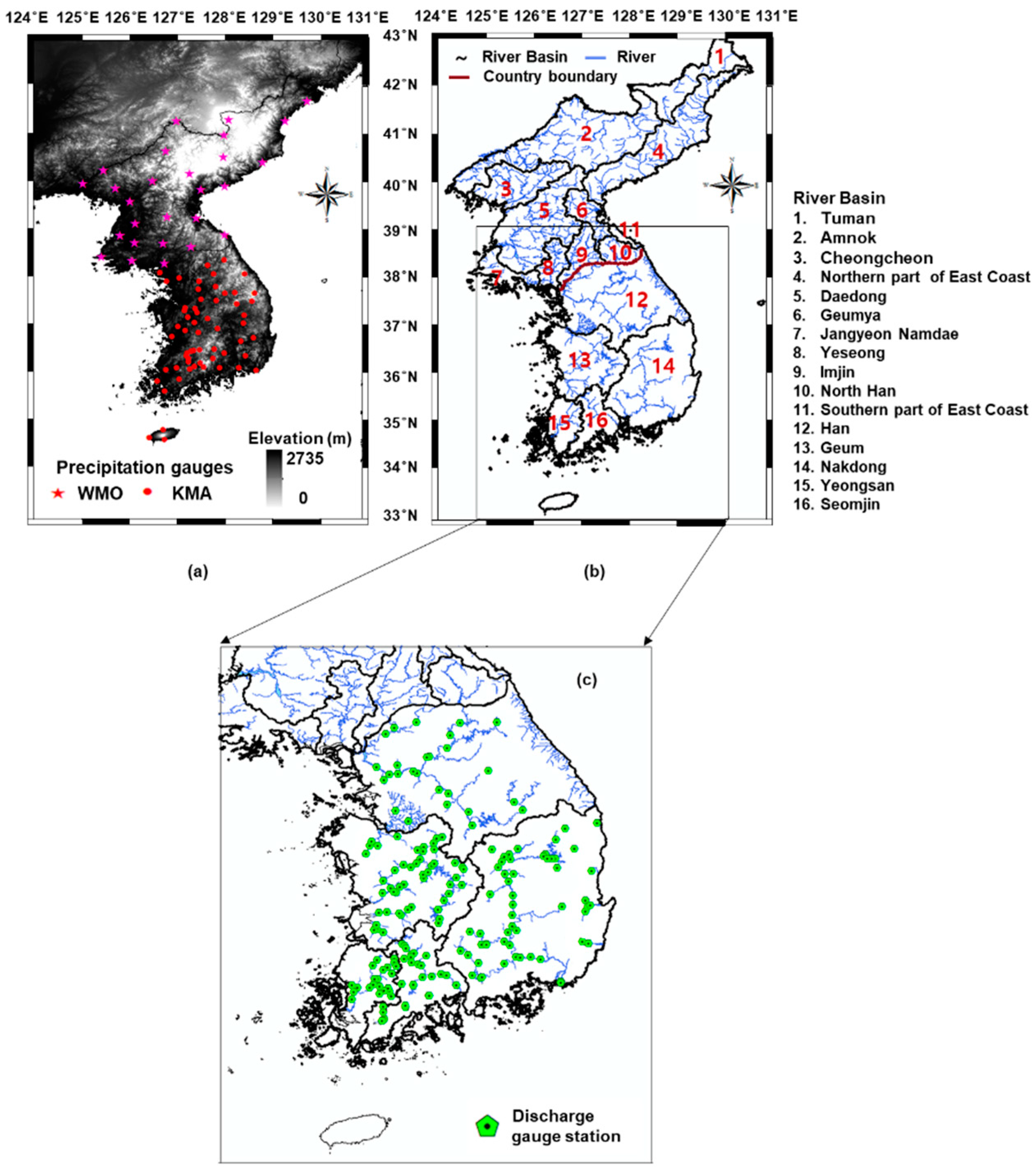
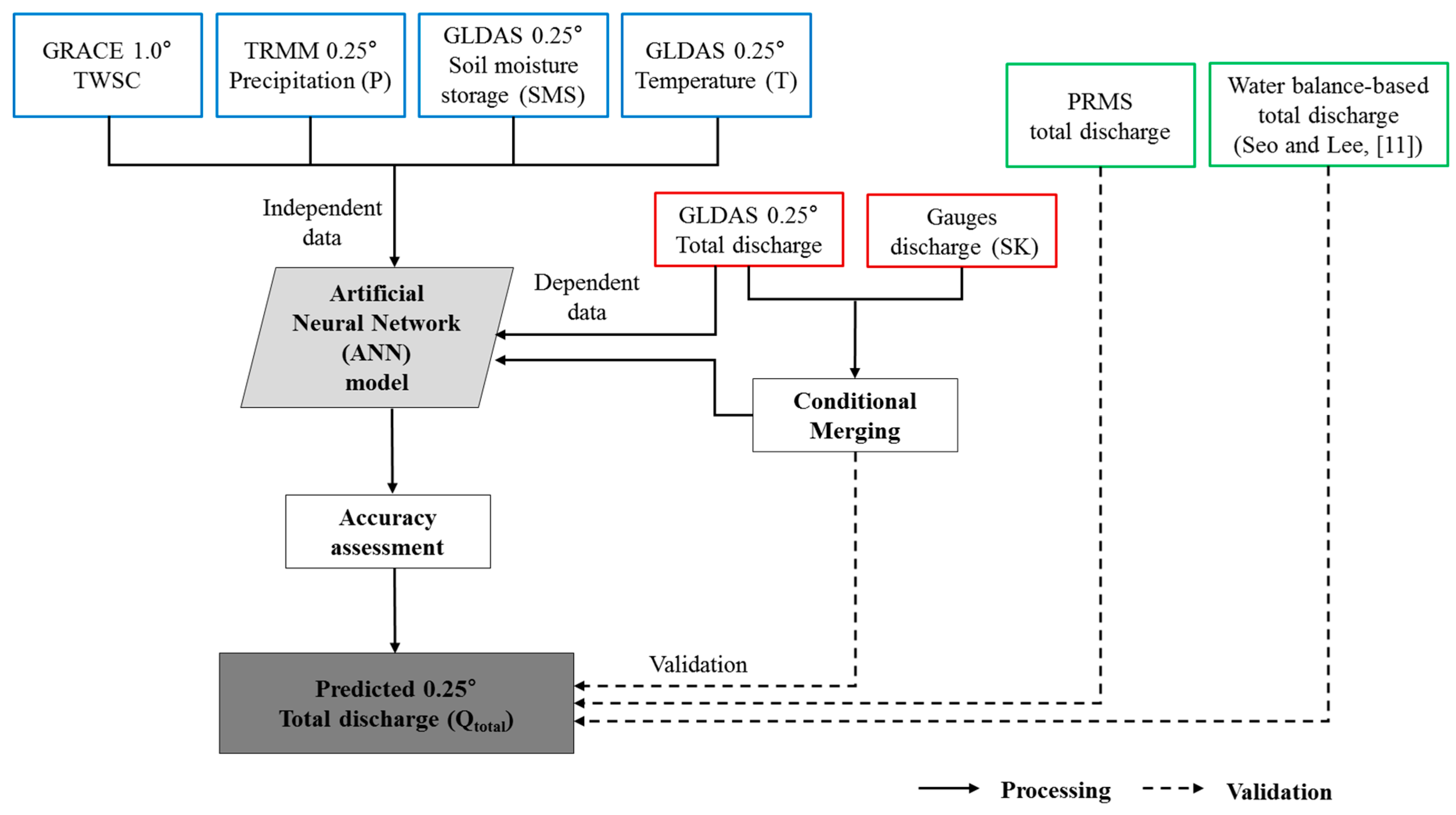
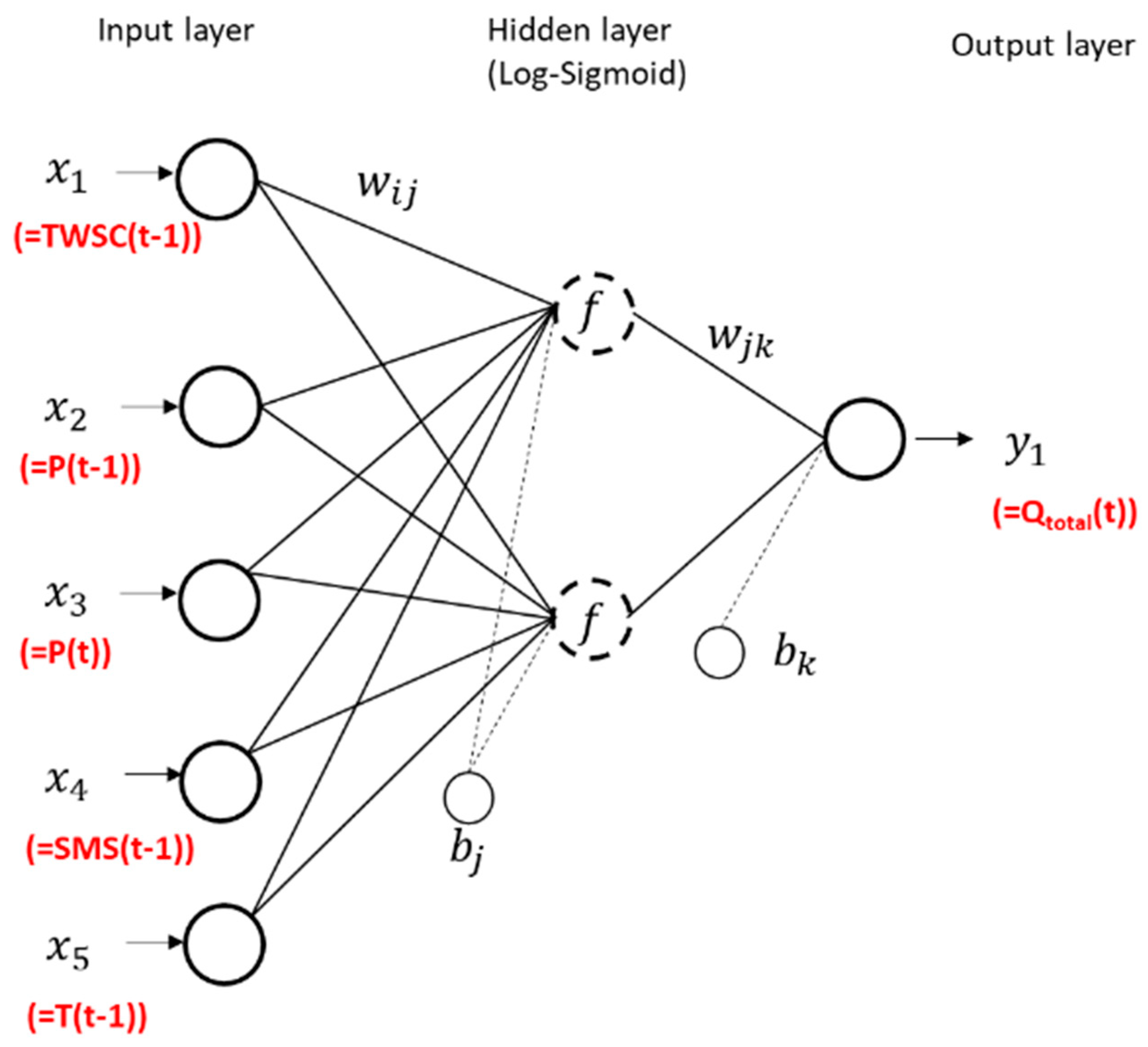
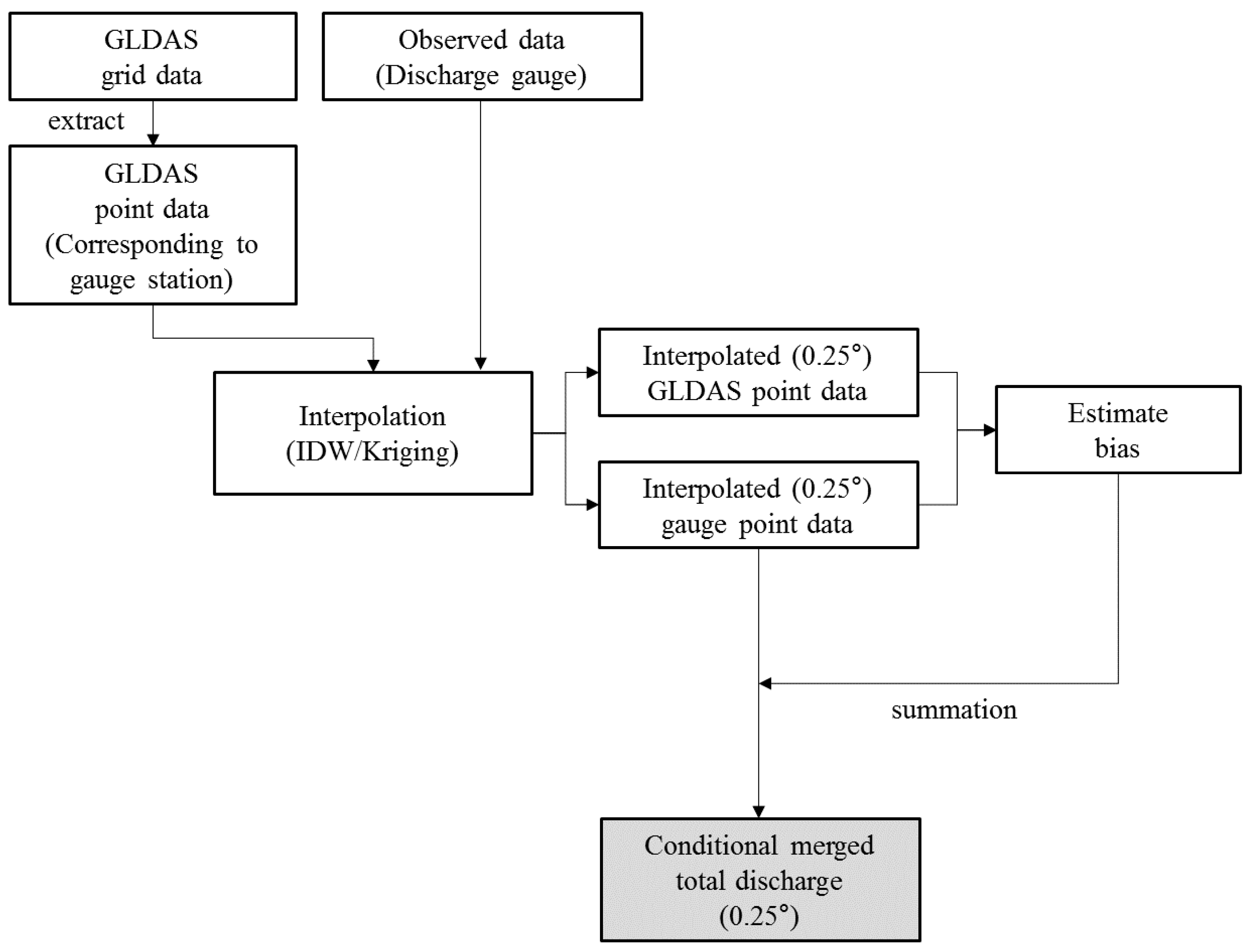
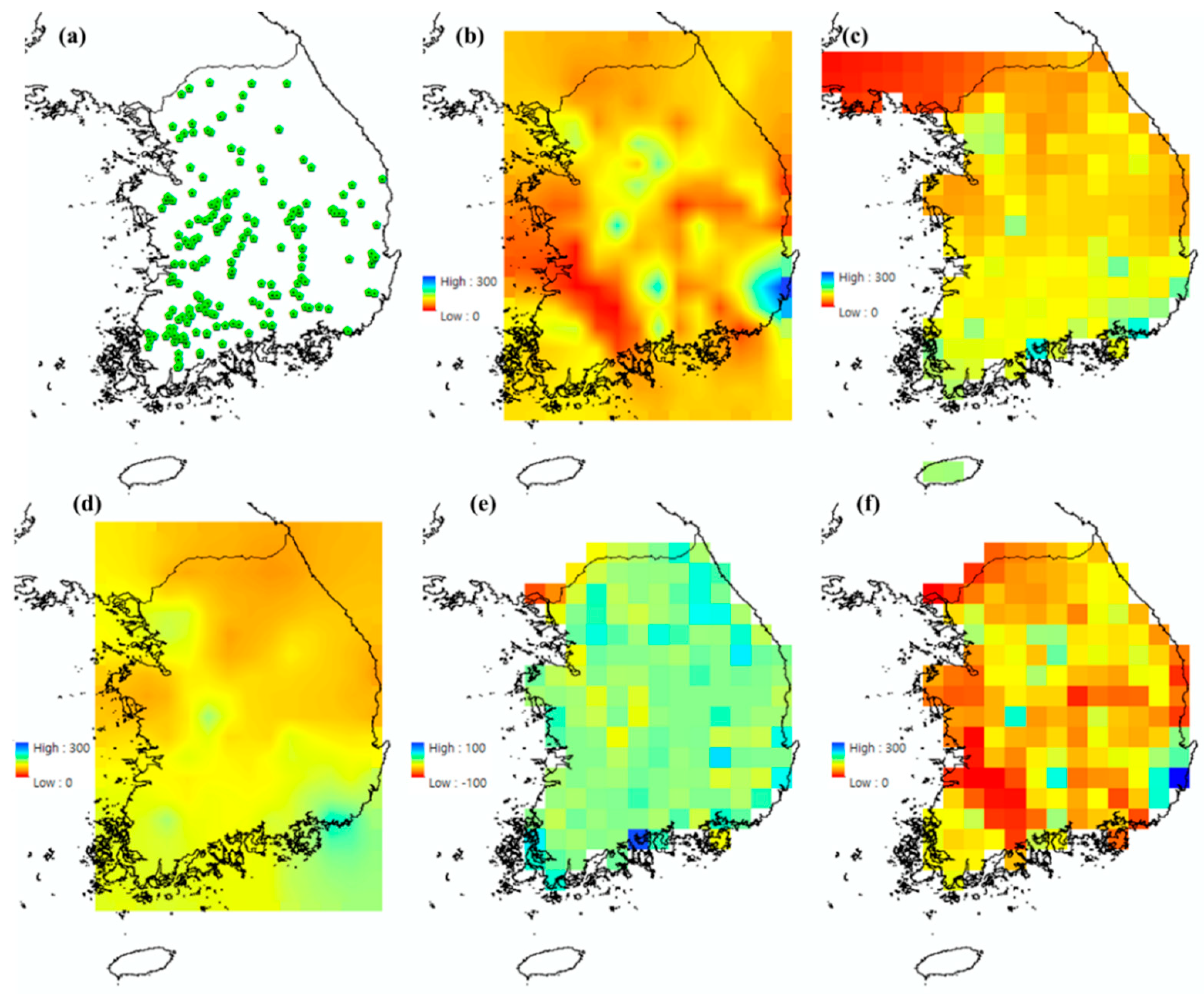
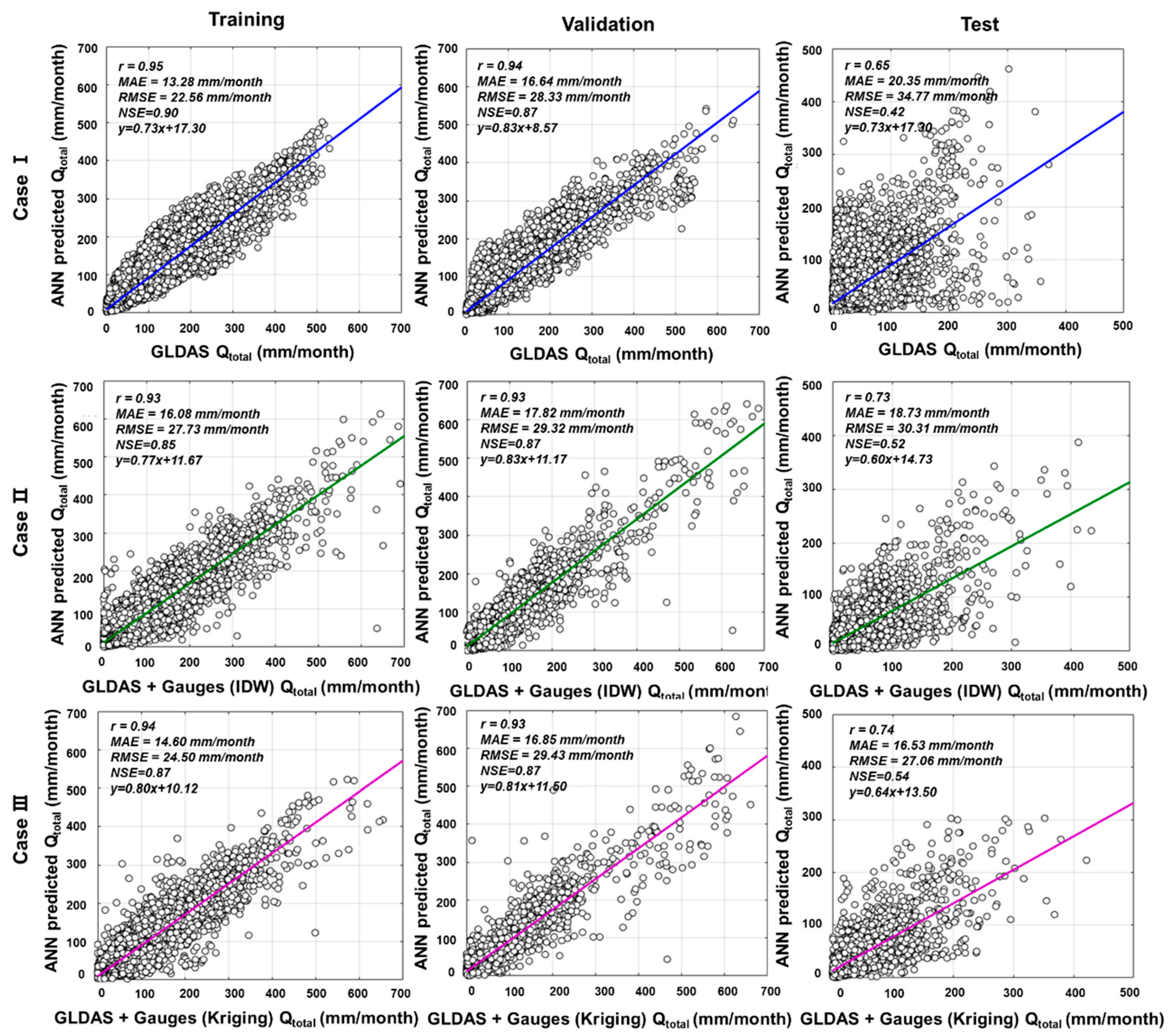
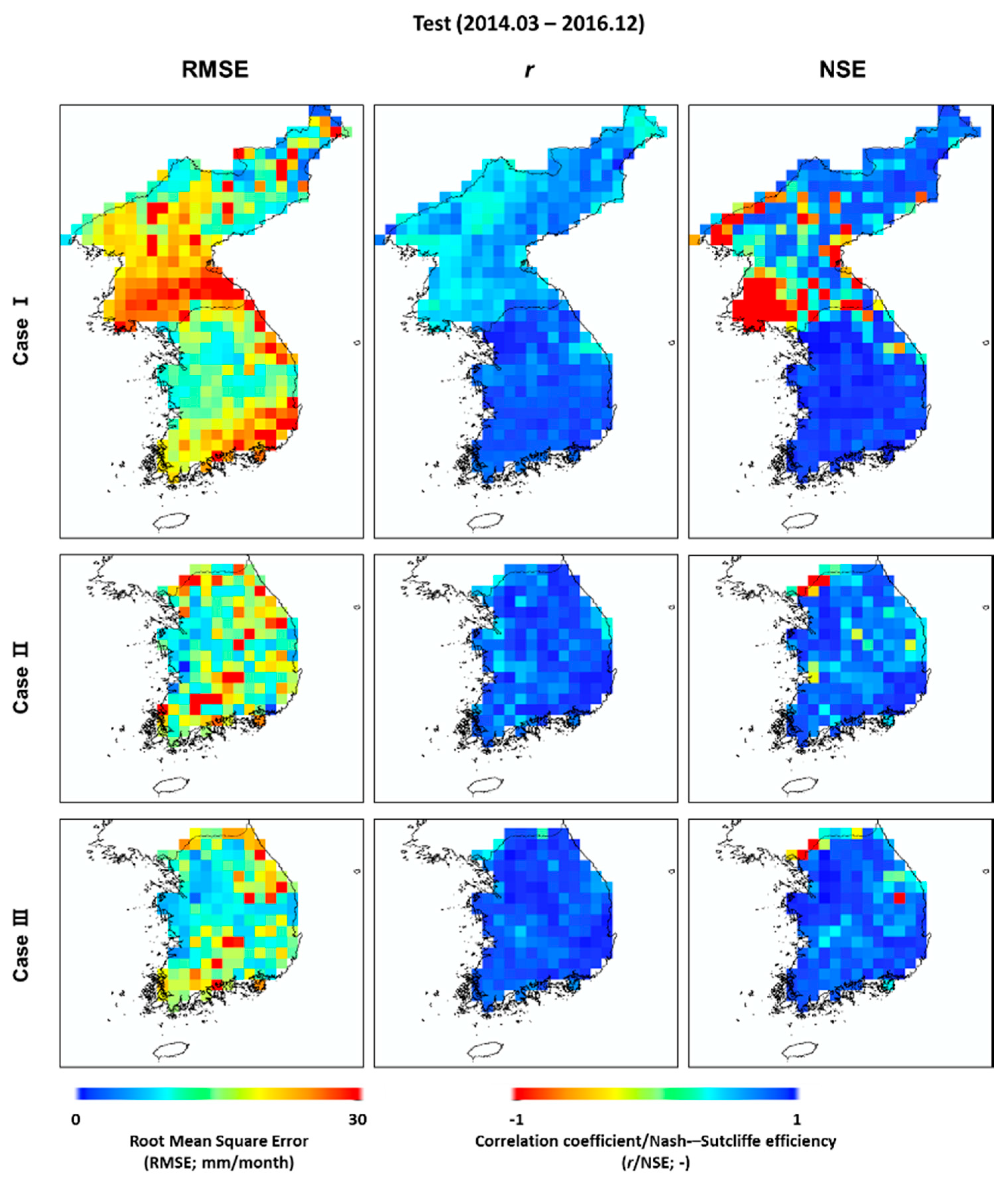

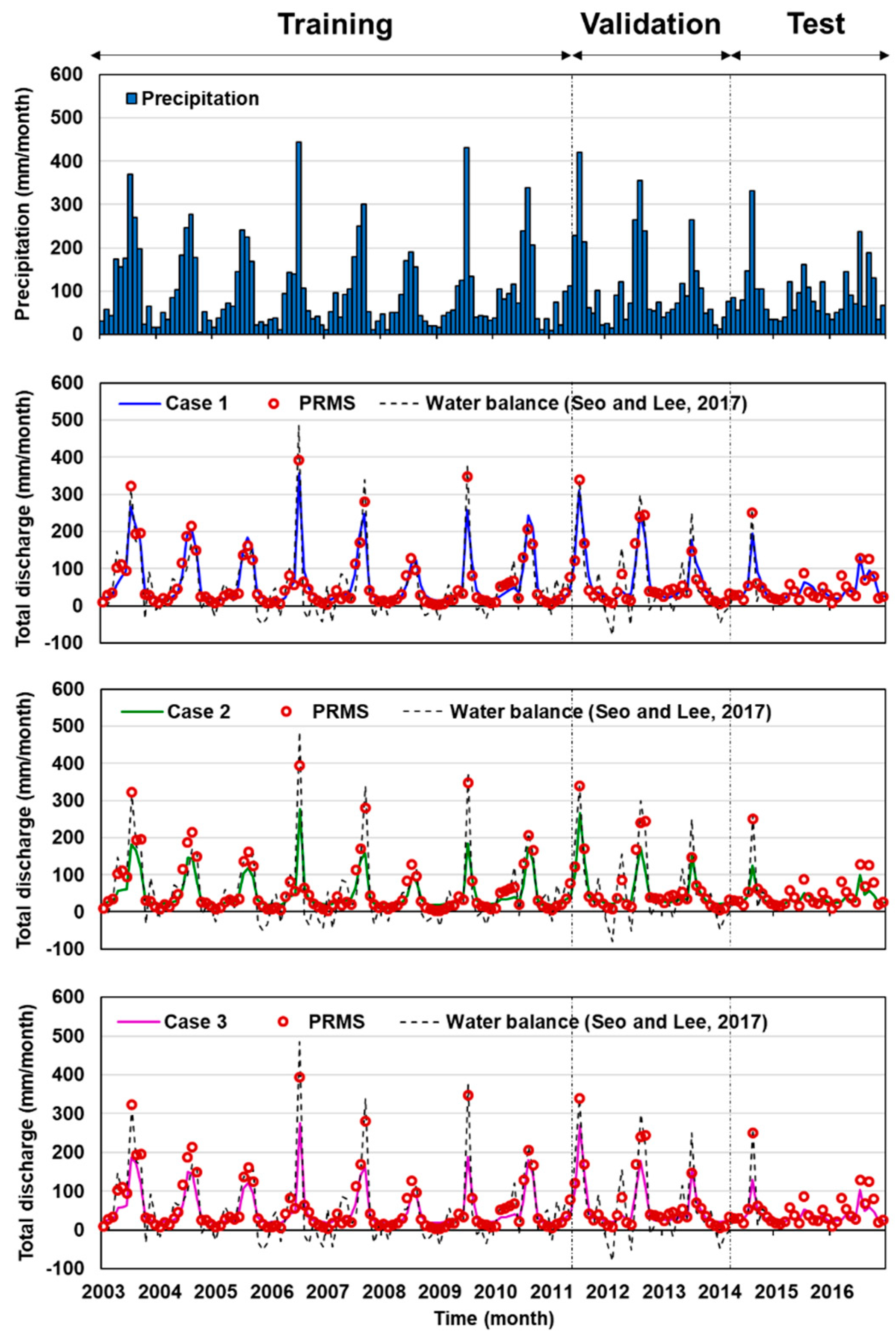
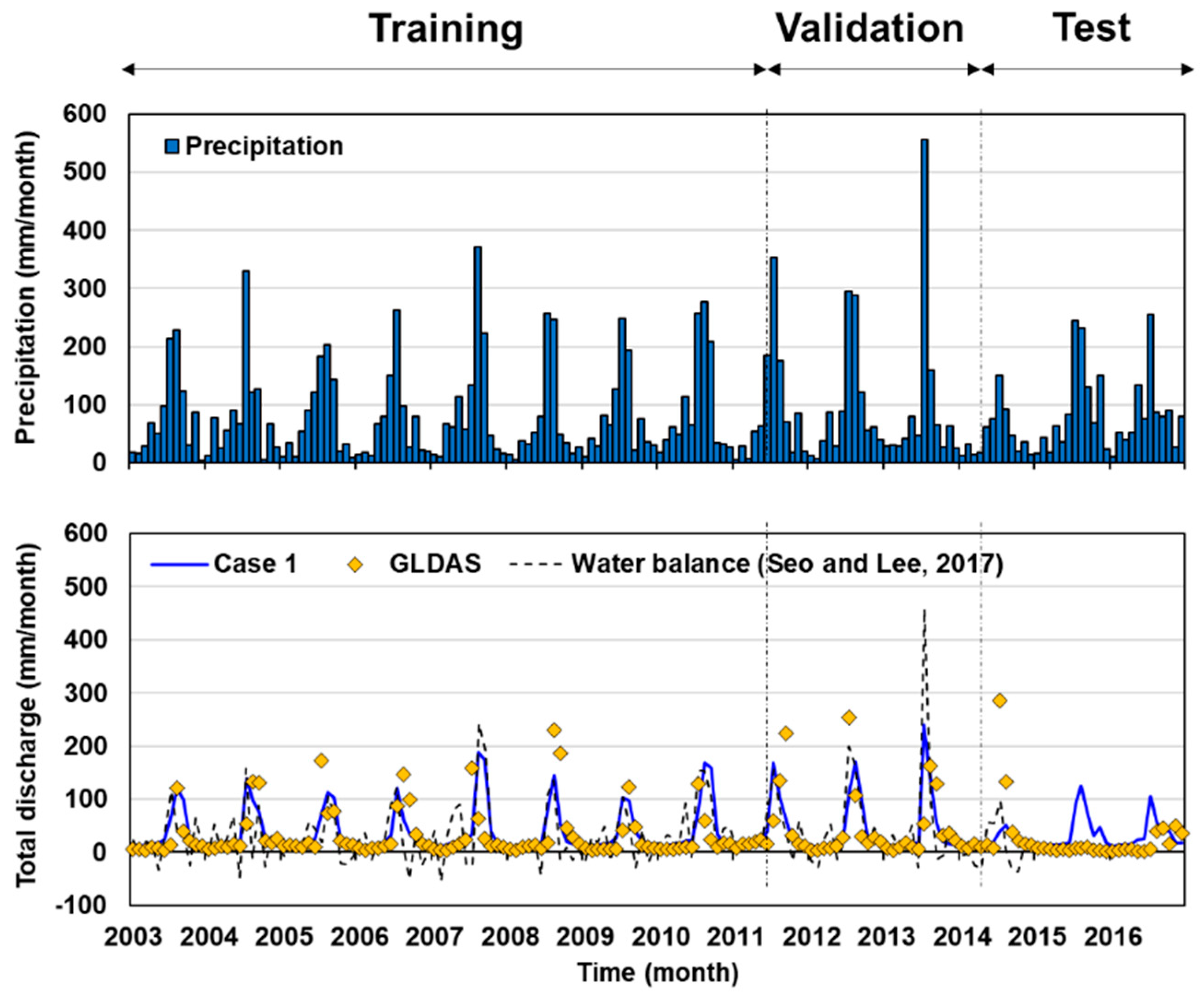
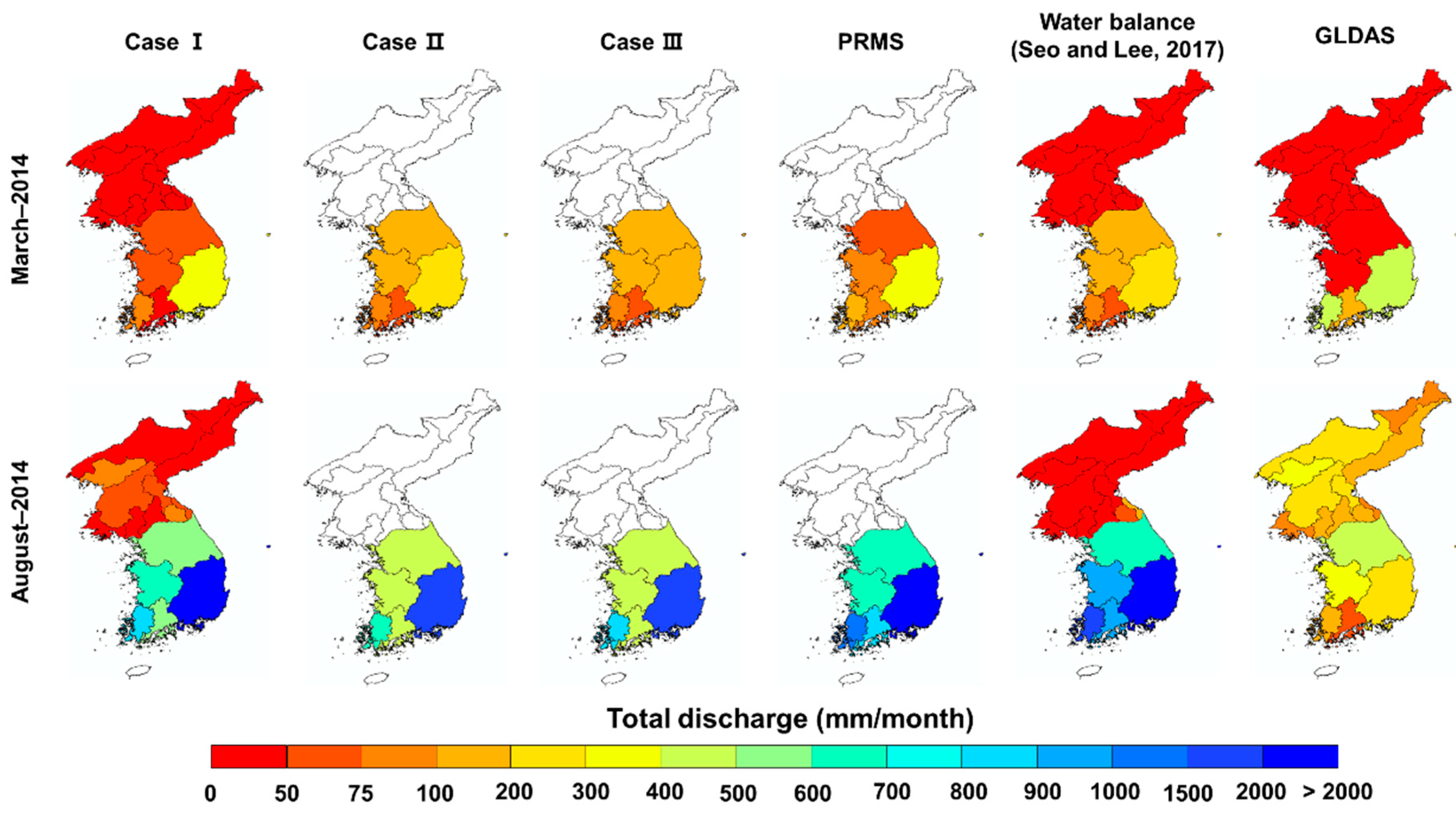
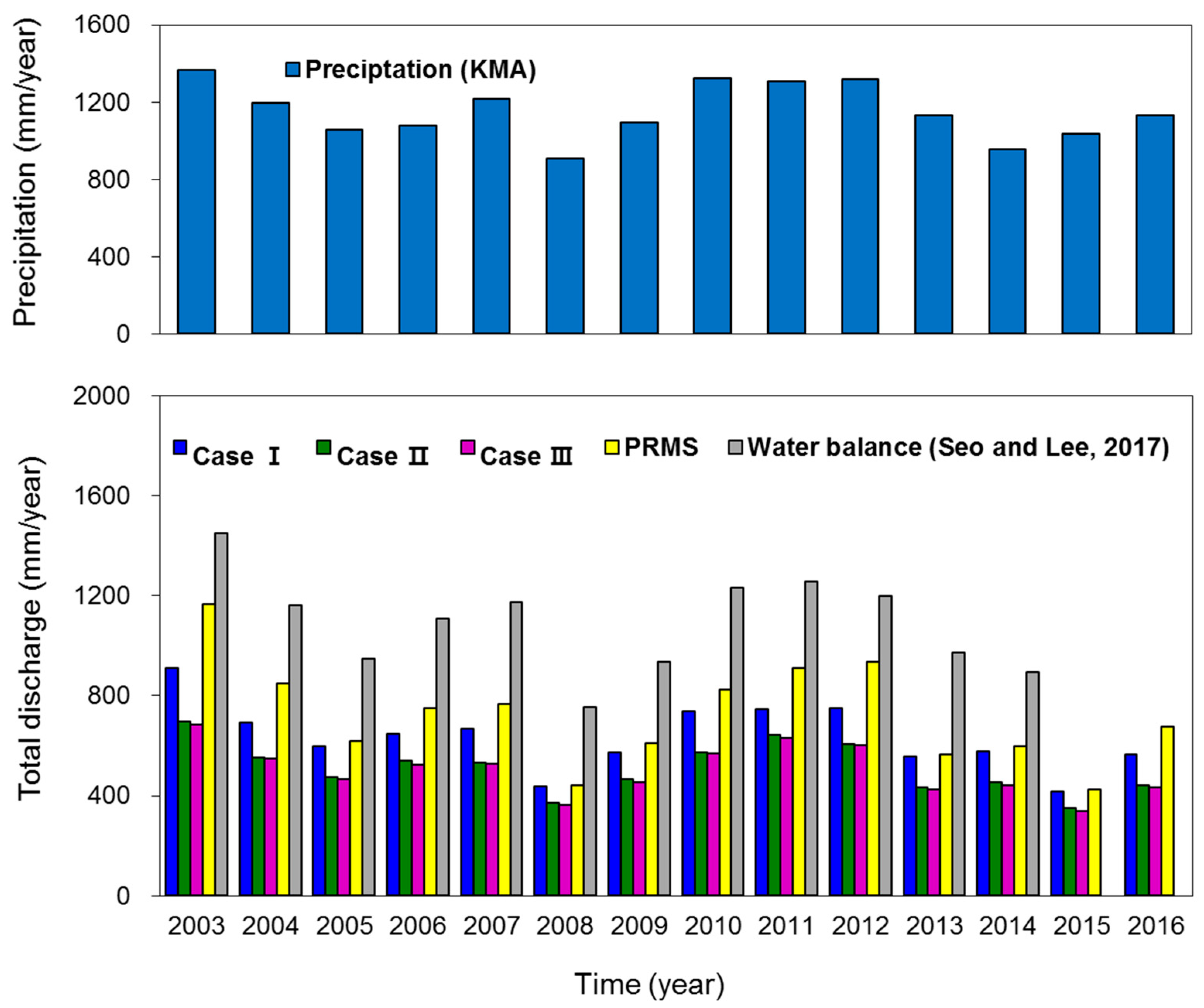
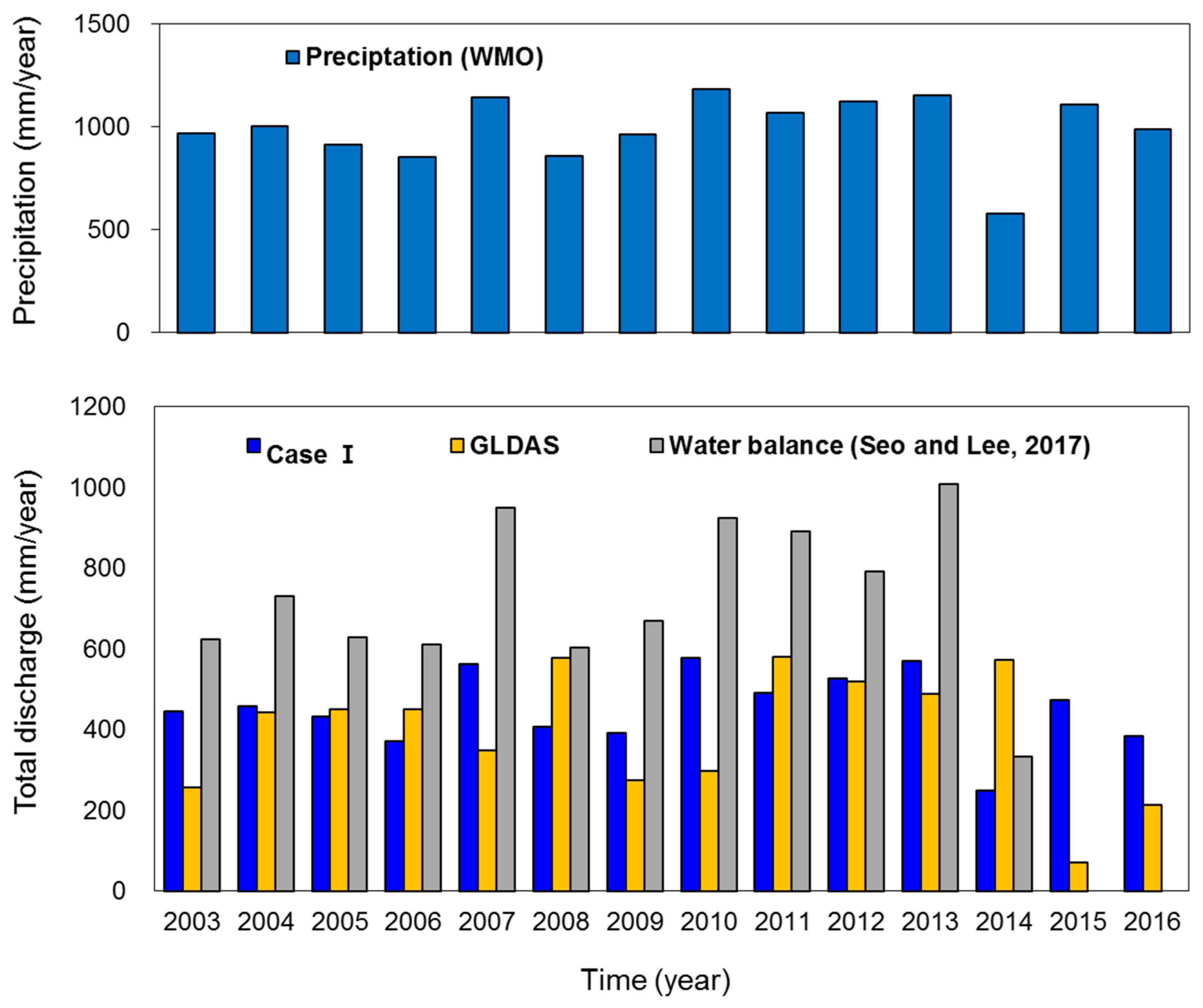
| River Basin | Area (km2) | Channel Reach (km) | |
|---|---|---|---|
| North Korea | Tuman | 10,290.7 (32,920.0) 1 | 547.8 |
| Amnok | 33,367.2 (64,739.8) 1 | 803.0 | |
| Cheongcheon | 9368.2 | 217.0 | |
| Northern part of East Coast | 14,249.9 | 981.8 | |
| Daedong | 19,371.8 | 450.3 | |
| Geumya | 3365.7 | 145.1 | |
| Jangyeon Namdae | 1271.8 | 107.9 | |
| Yeseong | 3932.5 | 187.4 | |
| Imjin | 5113.5 (8129.5) 2 | 272.4 | |
| North Han | 3095.6 (10,834.0) 2 | 317.0 | |
| Southern part of East Coast | 535.6 | 70.6 | |
| South Korea | Han | 26,219.0 (34,428.1) 3 | 483.0 |
| Geum | 9914.0 | 388.0 | |
| Nakdong | 23,690.3 | 511.0 | |
| Yeongsan | 3469.6 | 135.0 | |
| Seomjin | 4914.3 | 222.0 |
| Hydrologic Component | Data | Temporal Resolution | Spatial Resolution | |
|---|---|---|---|---|
| Independent | TWSC | GRACE RL05 | Monthly | 1.0° |
| Precipitation (P) | TMPA3B43 | 0.25° | ||
| Soil moisture storage (SMS) | GLDAS_NOAH025_M | |||
| Average temperature (T) | ||||
| Dependent | Total discharge (Qtotal) | GLDAS_NOAH025_M | Monthly | 0.25° |
| Gauges * | Daily | Point | ||
| Validation | Total discharge (Qtotal) | GLDAS_NOAH025_M | Monthly | 0.25° |
| Gauges * | Daily | Point | ||
| PRMS * | Local | |||
| Water-balance method (Seo and Lee [11]) | Monthly | 1.0° |
| Input Data | Target Data | Study Area (no. samples) | No. Neurons of Hidden Layer | |
|---|---|---|---|---|
| Case I | TWSC+P+SMS+T | Qtotal (GLDAS) | Korean peninsula (376 × 168) | 1~10 |
| Case II | Qtotal (GLDAS+gauges (IDW)) | South Korea (163 × 168) | ||
| Case III | Qtotal (GLDAS+gauges (Kriging)) |
© 2020 by the authors. Licensee MDPI, Basel, Switzerland. This article is an open access article distributed under the terms and conditions of the Creative Commons Attribution (CC BY) license (http://creativecommons.org/licenses/by/4.0/).
Share and Cite
Seo, J.Y.; Lee, S.-I. Fusion of Multi-Satellite Data and Artificial Neural Network for Predicting Total Discharge. Remote Sens. 2020, 12, 2248. https://doi.org/10.3390/rs12142248
Seo JY, Lee S-I. Fusion of Multi-Satellite Data and Artificial Neural Network for Predicting Total Discharge. Remote Sensing. 2020; 12(14):2248. https://doi.org/10.3390/rs12142248
Chicago/Turabian StyleSeo, Jae Young, and Sang-Il Lee. 2020. "Fusion of Multi-Satellite Data and Artificial Neural Network for Predicting Total Discharge" Remote Sensing 12, no. 14: 2248. https://doi.org/10.3390/rs12142248
APA StyleSeo, J. Y., & Lee, S.-I. (2020). Fusion of Multi-Satellite Data and Artificial Neural Network for Predicting Total Discharge. Remote Sensing, 12(14), 2248. https://doi.org/10.3390/rs12142248




